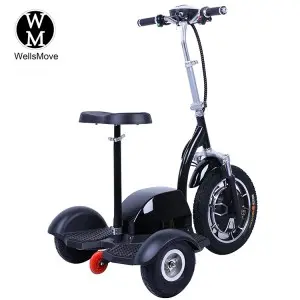Application of lead-acid batteries and lithium batteries in mobility scooters for the elderly: a comprehensive analysis of advantages and disadvantages
As the global aging trend intensifies, the market demand for mobility scooters for the elderly continues to rise. For international wholesale buyers, it is crucial to have a deep understanding of the characteristics of batteries, the core components of mobility scooters for the elderly. Lead-acid batteries and lithium batteries are the mainstream battery types in the current mobility scooter market, each with its own advantages. This article will deeply analyze the advantages and disadvantages of the two in mobility scooters for the elderly to help buyers make accurate decisions.
1. Advantages of lead-acid batteries in mobility scooters for the elderly
(I) Significant cost advantage
The manufacturing cost of lead-acid batteries is relatively low, only 1/3 to 1/5 of that of lithium batteries. This means that mobility scooters equipped with lead-acid batteries can effectively control costs in the production process, making the price of the whole vehicle more competitive. For price-sensitive elderly consumers and large purchasers such as nursing homes with limited budgets, this type of cost-effective mobility scooters for the elderly are more easily accepted and can meet their basic travel needs.
(II) Mature and reliable technology
After more than a hundred years of development, lead-acid battery technology has become mature and perfect. Its maintenance is relatively simple, and no complex and sophisticated battery management system is required, which reduces the technical threshold and cost of production and maintenance. The wide market application has made the quality and performance of lead-acid batteries withstand long-term tests, and its stability is well-known. In the use scenarios of elderly scooters, such as daily short-distance travel and low-speed driving, it can provide stable and reliable endurance support for the elderly and reduce the risk of travel obstruction due to battery failure.
(III) Good recyclability
The lead and sulfuric acid components of lead-acid batteries have high recyclability, and the lead recovery rate can reach more than 95%. This not only conforms to the current global environmental protection concept, but also reduces dependence on the exploitation of natural resources. At the end of the life cycle of elderly scooters, recycling and reusing lead-acid batteries can not only reduce environmental pollution, but also create certain economic value and achieve sustainable development.
2. Disadvantages of lead-acid batteries in elderly scooters
(I) Low energy density
The energy density of lead-acid batteries is usually 30-50Wh/kg, which is much lower than that of lithium batteries. At the same volume, the range of lead-acid batteries is limited. For the elderly who have long travel needs, they may need to be charged frequently, which affects the convenience of use. For example, if the elderly want to drive a mobility scooter to a slightly distant park or suburb for fun, the lead-acid battery may not be able to meet the range requirements of a single trip.
(ii) Large weight and volume
The high density of lead-acid batteries leads to relatively large weight and volume. This will increase the weight of the elderly mobility scooter, which is not conducive to the vehicle’s handling flexibility, especially in scenes such as turning and climbing, the driving experience will be affected to a certain extent. Moreover, the larger lead-acid battery may also occupy the limited storage space of the mobility scooter, reducing the space utilization rate of the vehicle.
(iii) There is a risk of pollution
If the discarded lead-acid batteries are not handled properly, the lead and acid in the battery may leak, causing serious pollution to the soil, water sources and other environments, and then endangering the ecosystem and human health. This puts high demands on the recycling and processing of batteries. Once there is a loophole in the processing link, it may cause environmental problems.
3. Advantages of lithium batteries in mobility scooters for the elderly
(I) High energy density
The energy density of ternary lithium batteries can reach 200Wh/kg, and that of lithium iron phosphate batteries is about 110Wh/kg. This allows mobility scooters equipped with lithium batteries to have a significantly longer range at the same battery weight, easily meeting the elderly’s daily long-distance travel needs, reducing the number of charging times and improving travel efficiency.
(II) Lightweight advantages
The weight of lithium batteries is only 1/3 to 1/4 of that of lead-acid batteries. This greatly reduces the weight of the mobility scooter for the elderly, making the vehicle more flexible and convenient to operate. Whether it is shuttling on urban roads or driving on rural trails, it can bring a more relaxed and pleasant driving experience to the elderly, and it is also conducive to improving the vehicle’s climbing performance.
(III) Long service life
The cycle life of lithium iron phosphate batteries exceeds 2,000 times, and that of ternary lithium batteries is about 1,000 times, which is several times that of lead-acid batteries. This means that under normal use, lithium batteries can be used for many years without replacement, reducing the maintenance cost of long-term use of mobility scooters for the elderly, and improving the product’s cost-effectiveness and use value.
(IV) Convenient and efficient charging
Lithium batteries support fast charging technology, which can restore a large amount of power in a short time, reduce the time the elderly have to wait for charging, and improve the timeliness and convenience of travel. For example, during a lunch break or a short break, the elderly can quickly recharge their mobility scooters and continue their subsequent journeys.
(V) Good temperature adaptability
Compared with lead-acid batteries, lithium batteries have more stable performance in different temperature environments and have stronger extreme temperature resistance. In cold winters or hot summers, lithium batteries can still maintain good charging and discharging performance and endurance, ensuring that elderly mobility scooters can operate stably throughout the year without problems such as a significant reduction in endurance or difficulty in charging due to temperature changes.
4. Disadvantages of lithium batteries in elderly mobility scooters
(I) Relatively high cost
The initial purchase cost of lithium batteries is several times that of lead-acid batteries, and the prices of raw materials such as cobalt and lithium required for their production fluctuate greatly, increasing the uncertainty of battery costs. This makes the price of elderly mobility scooters equipped with lithium batteries usually higher, which may exceed the procurement cost budget of some elderly consumers or nursing homes, limiting their market popularity.
(II) Safety needs to be improved
Lithium batteries may cause thermal runaway under abnormal conditions such as high temperature or overcharge, and there is a certain risk of combustion or explosion. Although the high-quality battery management system (BMS) can reduce the risk to a certain extent, the safety requirements for lithium batteries are always an important consideration in the use of mobility scooters for the elderly. Once a safety accident occurs, it will not only cause property loss, but also endanger the personal safety of the elderly.
(III) High requirements for charging facilities
In order to ensure its performance and life, lithium batteries have high requirements for the stability of parameters such as charging voltage and current, and need to be equipped with professional charging equipment. However, the charging facilities in some places where the elderly live may not be perfect. If an unmatched charger is used or charging is performed in an unstable power supply environment, the performance and life of the lithium battery may be affected, and even safety hazards may be caused.
(IV) Limited performance in low temperature environment
Although the overall temperature adaptability of lithium batteries is better than that of lead-acid batteries, their performance will still be affected in extremely low temperature environments, the cruising range may be attenuated to a certain extent, and the charging speed may also be slowed down. In some cold areas, when the elderly drive mobility scooters for the elderly, they still need to take warming measures to ensure the normal operation of lithium batteries.
5. Summary and Outlook
Lead-acid batteries occupy an important position in the low-end and mid-end mobility scooter market for the elderly due to their low cost, high reliability and good recyclability. They are suitable for elderly consumers with limited budgets and short-distance travel needs as well as cost-sensitive buyers. Although lithium batteries are more expensive, they are more competitive in the mid-to-high-end market, especially for the elderly who have long battery life, high performance requirements and focus on user experience, and wholesale buyers who have high requirements for product quality, due to their advantages such as high energy density, light weight, long life and convenient charging.
With the continuous advancement of battery technology and the gradual reduction of costs, the share of lithium batteries in the mobility scooter market for the elderly is expected to further expand in the future. At the same time, lead-acid batteries are also continuously improving and upgrading, such as adding graphene materials to improve performance, and will continue to coexist with lithium batteries in the market for a long time. International wholesale buyers should comprehensively weigh the advantages and disadvantages of lead-acid batteries and lithium batteries according to factors such as target market demand, consumer preferences, and cost budgets, and choose the appropriate battery type to provide the elderly with safer, more comfortable and convenient mobility scooter products to meet their increasingly diverse travel needs.
Post time: Jun-09-2025



